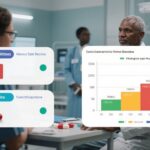Highlights
Zanidatamab, a bispecific antibody targeting HER2, combined with chemotherapy demonstrated a high objective response rate (76.2%) and durable clinical benefit in treatment-naïve patients with HER2-positive advanced gastro-oesophageal adenocarcinoma. The median progression-free survival reached 12.5 months, with median overall survival extending to 36.5 months. The combination therapy had a manageable safety profile, with diarrhoea and hypokalaemia as the most common grade 3-4 adverse events, and no treatment-related deaths reported.
Study Background and Disease Burden
Gastro-oesophageal adenocarcinoma is a significant global health challenge characterized by late-stage diagnosis and poor prognosis. Human epidermal growth factor receptor 2 (HER2) overexpression/amplification occurs in a subset of these tumors, providing a therapeutic target. Despite advances, outcomes remain suboptimal, and resistance to HER2-targeted therapies such as trastuzumab necessitates novel approaches. Zanidatamab, a dual-targeting bispecific antibody, engages two distinct HER2 epitopes, potentially enhancing antitumor efficacy. Prior studies in refractory HER2-expressing gastro-oesophageal adenocarcinoma showed promising activity and tolerability. This phase 2 study evaluated zanidatamab combined with standard chemotherapy as first-line treatment in HER2-positive advanced disease, addressing an unmet medical need.
Study Design
This multicentre, single-arm, phase 2 trial enrolled 46 patients across Canada, South Korea, and the USA with untreated, metastatic or advanced HER2-positive gastro-oesophageal adenocarcinoma. HER2 positivity was defined as immunohistochemistry (IHC) 3+ or IHC 2+ with fluorescence in situ hybridization (FISH) positivity. Eligible patients had Eastern Cooperative Oncology Group performance status 0-1. Zanidatamab was administered intravenously alongside one of three chemotherapy regimens: CAPOX (capecitabine plus oxaliplatin), FP (5-fluorouracil plus cisplatin), or modified FOLFOX6 (mFOLFOX6). The study comprised two parts: Part 1 focused on safety, tolerability, and dose determination; Part 2 assessed antitumor activity. Zanidatamab dosing employed weight-based and flat dosing regimens, adjusted per chemotherapy cycle length.
Primary endpoints included safety and tolerability in Part 1, and confirmed objective response rate (ORR) in Part 2, evaluated per RECIST criteria. Secondary endpoints comprised duration of response, disease control rate, clinical benefit rate, progression-free survival (PFS), overall survival (OS), and safety outcomes.
Key Findings
At a median follow-up of 47.9 months, the study demonstrated a confirmed ORR of 76.2% (95% CI 60.5-87.9), indicating a robust tumor response in the first-line setting. The median duration of response was 18.7 months (95% CI 10.4-44.1), underscoring the durability of treatment benefit. Median PFS was 12.5 months (95% CI 8.2-21.8), and median OS reached 36.5 months (95% CI 23.6-not estimable), exceeding historical benchmarks for this patient population.
Disease control rate and clinical benefit rate were 88.1% and 78.6%, respectively, reflecting broad disease stabilization and clinical improvement. Safety analysis revealed 65% of patients experienced treatment-related grade 3 or 4 adverse events. The most frequent were diarrhoea (39%) and hypokalaemia (22%). Implementation of mandatory antidiarrhoeal prophylaxis reduced grade 3 diarrhoea incidence from 39% to 24% in subsequent patients. Dose-limiting toxicities were rare, primarily involving gastrointestinal effects and acute kidney injury. No treatment-related mortality occurred, and 13% discontinued zanidatamab due to adverse events.
Antitumor activity in patients with HER2-expressing GEA (response evaluable analysis set)
| Zanidatamab monotherapya | Zanidatamab plus chemotherapyb | |||
|---|---|---|---|---|
| All GEA patients (N = 28) | Patients with HER2 + GEA (n = 27) | All GEA patients (N = 37) | Patients with HER2 + GEA (n = 26) | |
| cORR, n (%)
[95% CI] |
9 (32.1)
[15.9–52.4] |
8 (29.6)
[13.8–50.2] |
18 (48.6)
[31.9–65.6] |
13 (50.0)
[29.9–70.1] |
| cBOR, n (%) | ||||
| CR | – | – | 2 (5.4) | 2 (7.7) |
| PR | 9 (32.1) | 8 (29.6) | 16 (43.2) | 11 (42.3) |
| SD | 8 (28.6) | 8 (29.6) | 12 (32.4) | 10 (38.5) |
| PD | 11 (39.3) | 11 (40.7) | 7 (18.9) | 3 (11.5) |
| CBR,c n (%) | 11 (39.3) | 10 (37.0) | 21 (56.8) | 16 (61.5) |
| [95% CI] | [21.5–59.4] | [19.4–57.6] | [39.5–72.9] | [40.6–79.8) |
| DCR,d n (%) | 17 (60.7) | 16 (59.3) | 30 (81.1) | 23 (88.5) |
| [95% CI] | [40.6–78.5] | [38.8–77.6] | [64.8–92.0] | [69.8–97.6] |
| DOR, median (95% CI) mo, | 6.7 (1.9–11.1) | 7.4 (1.9–11.1) | 18.3 (5.6–NE) | 18.9 (3.7–NE) |
| [n] | [9] | [8] | [18] | [13] |
| PFS,e median (95% CI) mo | 3.6 (1.8–7.2) | 3.6 (1.8–7.2) | 7.3 (5.4–11.5) | 7.6 (5.4–20.1) |
| Had event, n/n (%) | 26/29 (89.7) | 25/28 (89.3) | 30/41 (73.2) | 18/27 (66.7) |
| Censored, n/n (%) | 3/29 (10.3) | 3/28 (10.7) | 11/41 (26.8) | 9/27 (33.3) |
Findings from the phase 1 trial investigating zanidatamab monotherapy or in combination with chemotherapy in previously treated HER2-expressing gastroesophageal adenocarcinoma complement these results, showing manageable safety and encouraging objective response rates of 32.1% with monotherapy and 48.6% with combination therapy in heavily pretreated patients.
Expert Commentary
The high response rates and prolonged survival observed with zanidatamab plus chemotherapy represent a significant advancement in first-line treatment of HER2-positive advanced gastro-oesophageal adenocarcinoma. The bispecific design of zanidatamab may overcome resistance mechanisms limiting efficacy of previous HER2-targeted agents like trastuzumab. The durable responses suggest robust tumor control, potentially translating into improved quality of life and survival benefit.
While the safety profile is consistent with known toxicities of HER2-directed therapies combined with chemotherapy, the manageable adverse event spectrum and absence of treatment-related deaths are reassuring. The observed gastrointestinal toxicities, particularly diarrhoea, can be mitigated with prophylactic measures, supporting tolerability in clinical practice.
Limitations include the single-arm design and relatively small sample size, which necessitate confirmation in randomized controlled trials. Additionally, the heterogeneity of chemotherapy backbones used may influence outcomes and complicate direct comparisons. Future studies should explore zanidatamab in combination with immunotherapy and in earlier disease stages.
Conclusion
Zanidatamab plus chemotherapy as first-line therapy for HER2-positive advanced gastro-oesophageal adenocarcinoma delivers clinically meaningful and durable antitumour activity with an acceptable safety profile. This therapeutic approach holds promise to improve outcomes in this challenging malignancy and warrants further investigation in larger, controlled studies to establish its role in standard care.
References
1. Elimova E, Ajani J, Burris H, Denlinger CS, Iqbal S, Kang YK, et al. Zanidatamab plus chemotherapy as first-line treatment for patients with HER2-positive advanced gastro-oesophageal adenocarcinoma: primary results of a multicentre, single-arm, phase 2 study. Lancet Oncol. 2025 Jul;26(7):847-859. doi: 10.1016/S1470-2045(25)00287-6 IF: 35.9 Q1 .
2. Meric-Bernstam F, Rha SY, Hamilton E, Kang YK, Hanna DL, Iqbal S, et al. Zanidatamab monotherapy or combined with chemotherapy in HER2-expressing gastroesophageal adenocarcinoma: a phase 1 trial. Nat Commun. 2025 May 8;16(1):4293. doi: 10.1038/s41467-025-59279-z IF: 15.7 Q1 .



